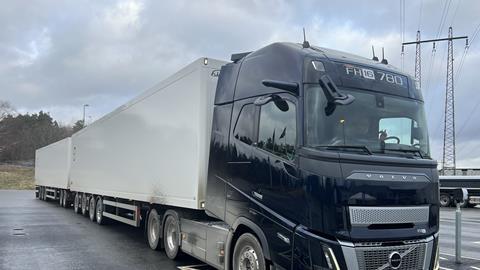While the EU transport sector has been fiercely debating proposed changes to lorry weights and dimensions over the past few months, Sweden, Denmark and Spain didn’t wait for the rules to be agreed - they took control and allowed double trailers on their domestic roads to reduce emissions, traffic and driver shortages.
In Sweden, the Swedish Transport Administration has introduced new rules that allow HGVs with two or three trailers and a total length of up to 34.5 metres on around 590 kilometres of road from 1 December 2023.
Two approved vehicle combinations mark the first stage of this project; the A-double (equivalent to two 40-foot containers in length) and the AB-double (equivalent to two 20-foot and one 40-foot container in length).
The move aims to improve transport efficiency, reduce environmental impact and cut heavy vehicle emissions by an estimated 4-6%. The longer trucks are also expected to optimise logistics processes, reduce costs and improve companies’ competitiveness.
Until December, Finland was the only country in Europe to allow such vehicle combinations, but in parallel with Sweden, other countries were considering going down this route.
One of them was Denmark, which introduced a similar long truck policy just a month later: a trial scheme for double-trailer combinations (EMS2) was launched on 1 January 2024.
The Danish Transport Administration has amended Section 70a of the Road Traffic Act to allow several trailers to be coupled together in a double-trailer combination: a tractor with two semi-trailers, with a dolly connecting the rear semi-trailer to the front.
The new regulations allow semi-trailer combinations with a maximum length of 34.00 metres and a maximum weight of 72 tonnes. Technical specifications, including electronic stability control (ESC) and safety features such as anti-lock braking systems (ABS) and electronic braking systems (EBS), are set out in a new regulation.
The trial scheme is designed to allow companies to maximise the use of existing equipment, potentially leading to more efficient and sustainable transport practices.
Moving south, Spain has also followed in Sweden’s footsteps by approving the use of double trailers; sets of vehicles 32 metres long and weighing 72 tonnes. This decision was taken even though there were no officially approved regulations for this type of transport.
It should be added, however, that the approval of such long sets has long been expected, as a pilot project has seen one hundred 72-tonne trucks on Spanish roads since 2018, mainly used by logistics companies and fleet managers to transport goods for the automotive industry.
Germany and Denmark have gone one step further: the two countries signed a cross-border agreement on 4 December 2023, according to which Denmark allows the use of German Type 1 long lorries (semi-trailer combinations with a prescribed maximum length of 17.88 metres) on most of its roads from 1 January 2024.
For semi-trailers, the criteria include a maximum distance of 13.38 metres between the axis of the kingpin and the rear end and a horizontal distance of no more than 2.04 metres between the axis of the kingpin and any point on the front end of the semi-trailer.
In the case of special loads, longer vehicle combinations are allowed up to a length of 22 metres.
In addition, vehicles equipped with a loading crane with a capacity of more than 8 tonnes can have an extra length of up to 0.62 metres.
Meanwhile, the EU has been working hard to find different ways of encouraging hauliers to choose more environmentally friendly solutions than 40-tonne diesel lorries. One version of this ‘persuasion plan’ is a proposed amendment to the Weights and Dimensions Directive.
The changes to the directive would be particularly favourable to zero-emission lorries, which could be up to 2 tonnes heavier and 15 cm longer than their fossil-fuelled counterparts, with an additional 4-tonne exemption for intermodal transport.
Also, individual axles could see significant weight increases, with drive axles reaching 12.5 tonnes and tandem axles up to 20 tonnes for certain vehicle types.
In addition, these environmentally friendly vehicles could even carry 4.3-metre-high cube containers on regular trailers.
But it was not the zero-emission HGV regulations that stole the show. For internal combustion engines, the most notable change would be a potential increase in the maximum weight for 6-axle vehicles to 46 tonnes.
More importantly, the proposed directive would facilitate the cross-border operation of European Modular Systems (EMS), the longer and/or heavier combinations of conventional vehicles, between Member States. To be fair, this would only apply to countries that already allow such cross-border operations.
Incentives for intermodal transport would be particularly encouraged. Road hauliers using their lorries, trailers and semi-trailers in intermodal operations would benefit from an extra 4 tonnes of weight, and an extra height would be allowed for the carriage of high cube containers, allowing standard vehicles to participate in this type of intermodal transport.
It’s no wonder that reactions to these proposals have been fierce: while Dutch hauliers have called for more ambitious changes to weight limits, European rail organisations have warned that making road transport more competitive will do nothing to shift freight from road to rail - one of the original aims of the directive.
The debate is far from over.














